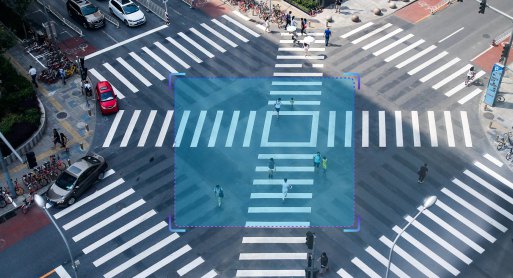
Crowd Overcrowding Detection

Algorithm Introduction
Utilizing AI vision algorithms to assess crowd density in specific scene videos or live feeds, calculating crowd size based on density metrics and triggering alerts when predefined thresholds are exceeded. This system provides dynamic crowd movement analysis for large-scale event security, enhancing smart security operations.
- ● Camera requirements:
- a) Installation height: 4-6 meters, with video resolution of 1080p (1920×1080) requiring minimum human height of 50 pixels
- b) Head detection: >30 pixels per head, <90 pixels per body, with ≤50% head occlusion allowed
- ● Lighting conditions:
- a) Daytime outdoor environments; performance degraded under nighttime conditions or strong backlighting causing low target visibility
- b) Normal indoor lighting; accuracy affected under insufficient illumination
Application Value
-

Urban Roadways
Through video analysis, the density of crowds can be accurately captured, and an early warning can be issued if the crowd is too dense, helping managers to flexibly deploy security and service resources and maintain order in the venue. -

Parks/Campuses/Commercial Zones/Tourist Attractions
By analyzing video footage to precisely monitor crowd density, the system issues immediate alerts when overcrowding occurs. This empowers managers to flexibly allocate security and service resources, ensuring orderly operations at the venue. -

Bus/Subway Stations, Railway Exits
Real-time monitoring of passenger flow at station entrances and exits through algorithms enables dynamic overcrowding alerts, assisting operators in optimizing train scheduling and crowd management strategies to enhance travel safety.
FAQ
-
Algorithm AccuracyAll algorithms published on the website claim accuracies above 90 %. However, real-world performance drops can occur for the following reasons:
(1) Poor imaging quality, such as
• Strong light, backlight, nighttime, rain, snow, or fog degrading image quality
• Low resolution, motion blur, lens contamination, compression artifacts, or sensor noise
• Targets being partially or fully occluded (common in object detection, tracking, and pose estimation)
(2) The website provides two broad classes of algorithms: general-purpose and long-tail (rare scenes, uncommon object categories, or insufficient training data). Long-tail algorithms typically exhibit weaker generalization.
(3) Accuracy is not guaranteed in boundary or extreme scenarios.
-
Deployment & InferenceWe offer multiple deployment formats—Models, Applets and SDKs.
Compatibility has been verified with more than ten domestic chip vendors, including Huawei Ascend, Iluvatar, and Denglin, ensuring full support for China-made CPUs, GPUs, and NPUs to meet high-grade IT innovation requirements.
For each hardware configuration, we select and deploy a high-accuracy model whose parameter count is optimally matched to the available compute power.
-
How to Customize an AlgorithmAll algorithms showcased on the website come with ready-to-use models and corresponding application examples. If you need further optimization or customization, choose one of the following paths:
(1) Standard Customization (highest accuracy, longer lead time)
Requirements discussion → collect valid data (≥1 000 images or ≥100 video clips from your scenario) → custom algorithm development & deployment → acceptance testing
(2) Rapid Implementation (Monolith:https://monolith.sensefoundry.cn/)
Monolith provides an intuitive, web-based interface that requires no deep AI expertise. In as little as 30 minutes you can upload data, leverage smart annotation, train, and deploy a high-performance vision model end-to-end—dramatically shortening the algorithm production cycle.





